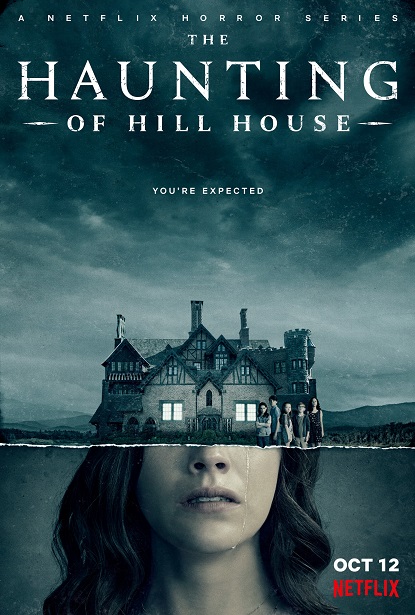The Haunting of Hill House
Introduction
“A ghost can be a lot of things. A memory, a daydream, a secret. Grief, anger, guilt. But, in my experience, most times they’re just what we want to see.”
As far as his thoughts on the afterlife are concerned, acclaimed novelist Steven Crain is clearly not in the habit of mincing words. He barely hesitates to debunk a grieving widow’s beliefs about her departed husband, and he solemnly chalks up his troubled childhood to his mother’s insanity and his father’s apathy. While he makes a living by telling unsettling stories of his early years spent at the Hill House – stories that, unlike his younger siblings, he himself never really believed in – events unfolding on the other side of the country in rural Massachusetts threaten to engulf the broken Crain family in chaos that has been long overdue.
Some ghosts transcend the fetters of time and space, and some hauntings can last a lifetime. As for Hugh Crain and his five children – Steve, Shirl, Theo, and twins Luke and Nellie – their haunting truly began the night they left Hill House and its manifest terrors behind. Based loosely on Shirley Jackson’s novel of the same name and told through the masterful lens of the inimitable Mike Flanagan, this award-winning Netflix original is light years away from your run-of-the-mill horror screamfest. It’s an unparalleled chronicle of trauma, alienation, and bereavement, oftentimes bridging the gap between what is and what should have been – an orchestra of emotions making its way towards a conclusive crescendo that will move you to tears.
STORY & SCREENPLAY
On a fateful summer night of 1992, a distraught Hugh Crain pulls his children out of their beds and quietly drags them to the car, away from the dark corridors of the Hill mansion where they had been residing for the previous couple of months as house flippers. With his deeply deranged wife Olivia close behind at their heels, the rest of the family barely make their escape from the estate, having no choice but to leave her alone behind. Morning brings news of Olivia’s suicide, and in its wake, enough grief and guilt to shatter the Crain family forever. Over the two decades that follow, Hugh grows mildly psychotic and increasingly distant from his children, each of whom tries to process the trauma in their own unique way. While all five siblings remember paranormal apparitions and occurrences at Hill House and their mother’s slow descent into madness, not all of them are ready to accept it – Steven chooses to live in denial of his memories of anything supernatural, while Luke turns to heroin and ends up in rehab. Shirley, now a mortician who owns a funeral home with her husband Kevin, is often too self-righteous to get along with others; and Theodora is a child psychologist with the gift of a clairvoyant touch, which has cursed her instead with a life of self-isolation and “walls” around her relationships. Things hit rock bottom when youngest sister Eleanor, who is the most vulnerable of the lot and has barely kept her demons suppressed for years, sets off on a downward spiral following the sudden death of her husband – until her loneliness and grief drive her back to Hill House where she seemingly kills herself.
The beautifully crafted screenplay does complete justice to this sprawling story arc and the events about to unfold in its wake. Each of the first five episodes focuses on a particular sibling up to the precise moment of Nellie’s death, thoroughly exploring each character’s childhood milieu and adult psyche, and setting the stage for the tragic family reunion to come. From Theo momentarily using her ability to help an abused foster kid, to Luke’s fleeting intimacy with a fellow addict in rehab, all the way to the twisted interpretation of “homecoming” that convinces a clinically depressed and abandoned Nellie to venture back into the gaping maw of Hill House – the first half of the series is replete with grim subtexts alluding to the central themes of the tale. The second half, set off by the Crain family gathering at Nellie’s funeral, is relatively tight-paced, leading towards an inescapable climax at Hill House. Halfway through the story, the ghosts no longer scare you as much as they sadden you, as we near the tearjerking finale that will give you chills and stay with you for ages.
The non-linear narrative, which keeps flipping back and forth between the sepia-tinted hallways of Hill House and the more austere shades of the present, has classic Flanagan written all over it. In addition to highlighting major plot points and the symbolic devices strewn throughout the story, it occasionally provides some much needed breathers for pondering those moments without feeling too overwhelmed. The transitions across the two time periods are visually seamless, with minor incidents from the past often poignantly foreshadowing much larger events in the distant future. These include, for instance, young Shirley rescuing the five orphaned kittens whom she eventually fails to save despite her best intentions and maternal efforts, or how young Nellie vanishes during the raging storm and later reappears crying inconsolably – “I didn’t go anywhere, I was right here the whole time…none of you could see me, nobody could see me…”. As the scene switches to Eleanor’s spectre standing in front of her open casket in an empty parlor with these lines repeating over and over, you cannot help but feel as guilty as the remaining members of her family, as you sense the estrangement and desolation she struggled with during her final days – and how different everything could have been, had any of her three elder siblings chosen to pick up the phone…
PERFORMANCE & DIRECTION
Speaking of the adult Crain siblings, Michiel Huisman is flawless as Steven, whose cynicism is firmly rooted in childhood trauma and the inability to acknowledge it; the perennial exasperation of Shirley and fierce isolation of Theodora are masterfully depicted by Elizabeth Reaser and Kate Siegel, while Oliver Jackson-Cohen’s performance as the recovering heroin-addict Luke does complete justice to his internal struggles and misgivings. But for me, the unambiguous star of the show is Victoria Pedretti, whose stellar portrayal of Eleanor Crain-Vance simply cannot be eclipsed! As the misunderstood sibling, all the hopes and joys and heartbreaks experienced by the empathetic Nell have been expressed to absolute, stunning perfection by Pedretti, who went on to earn several award nominations for her role. She will be nothing but Nellie to me for a long, long time!
Apart from them, Henry Thomas (later Timothy Hutton) and Carla Gugino have formidable screen presence as Mr. and Mrs. Crain, and all the child actors and actresses (Mckenna Grace as young Theodora and Lulu Wilson as young Shirley in particular) deliver incredibly mature performances. The rest of the side characters have been brought to life by a host of equally talented artists, whose brief moments of shining serve as crucial plot devices. While the housekeeping couple Clara (Annabeth Gish) and Horace Dudley (Robert Longstreet) have limited screen time, Horace’s chilling monologue in episode 7, for instance, steals the show and will surely give you the shivers!
The camera choreography of episode 6 (“Two Storms”) is the epitome of Flanagan’s directorial brilliance. Shot across the present in Shirley’s funeral home and the past in Hill House, the hour-long episode consists of only five long shots, with the half-lit passageways bridging the two parallel storylines both literally and figuratively. The sheer scale of effort and clockwork synchronicity that went into the mise-en-scène can be gleaned from behind-the-scene clips and the crew members’ own accounts, and are enough to make anyone dizzy. The dynamic color palette and weather effects subtly accentuate every frame in every episode, underpinning their emotional flavours with painstaking sincerity. Scattered throughout the story are plenty of Flanagan’s signature single-shot monologues, offering in-depth peeks into the inner workings of each character’s mind. Jumpscares are few and far between, taking a back seat (literally at times) compared to the haunting atmosphere and sustained tension which are enough to keep you hooked. Keep an eye out for the Bent-Neck Lady though, as she will hit you right in the chills and the feels when you least expect her. Also if you’re an eagle-eyed viewer, try to spot all the unassuming ghosts lurking in the shadowy backgrounds of the Hill House frames. They are the director’s handpicked Easter eggs for keen enough fans!
Lastly, the music is a treat in itself! From the haunting grandeur of the titular theme to the minimalistic melody of “Go Tomorrow”, the series uses an original album of 27 tracks composed by The Newton Brothers, alongside a handful of other celebrated songs which suit the story like a dream (special nod to “If I Go, I’m Goin” by Gregory Alan Isakov). Make sure to check them out separately!
SYMBOLISM & SUBTEXTS
Hidden beneath the visible storyline, there are multiple layers of symbolism that make The Haunting of Hill House the masterpiece it truly is. As speculated by one viewer and later confirmed by Flanagan, the Crain siblings, in descending order of age, represent the five successive stages of grief – denial, anger, bargaining, depression, and acceptance. Seeing how the series is a commentary on generational trauma that has been repressed far too long in a family, and judging by the distinct coping mechanisms of the characters in question, this couldn’t make more sense! The shape-shifting Red Room, little Abigail’s cup of stars, and Olivia’s elusive “forever house” – all carry deep symbolic significance linked to various aspects of a troubled mind. These psychological subtexts are immensely rewarding upon multiple viewings.
CONCLUSION
“I was born 90 seconds before Nell”, said Luke at Nellie’s funeral – “but she was always my big sister”. These words ring with newfound clarity as the so-called horror story draws to a close as a parable of atonement and togetherness – and between “whatever walked there walked alone” and “those who walk there walk together”, everything else really becomes confetti.
In addition to being one of the best works of horror fiction I’ve ever watched, The Haunting of Hill House is one of the best works of fiction I’ve watched on screen by far. This series deserves every bit of praise and accolades it has received and then some. As I sit for the fifth rewatch, I can’t recommend this gem enough!
Disclaimer: The above review solely illustrates the views of the writer.




